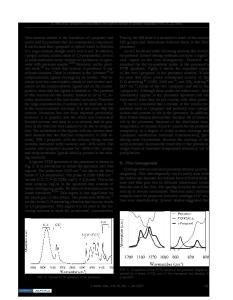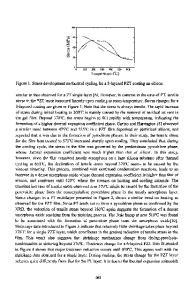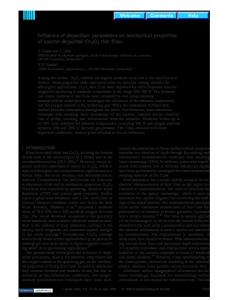Microstructure and properties of PbZr 0.6 Ti 0.4 O 3 and PbZrO 3 thin films deposited on template layers
- PDF / 788,432 Bytes
- 10 Pages / 612 x 792 pts (letter) Page_size
- 56 Downloads / 355 Views
N. Chen,b) G.R. Bai, Y. Huang,c) and S.K. Streiffer Materials Science Division, Argonne National Laboratory, Argonne, Illinois 60439-4838 (Received 30 September 1999; accepted 21 June 2000)
Polycrystalline Pb(ZrxTi1−x)O3 thin films with x ⳱ 0.6 and 1.0 were deposited at low temperatures (450–525 °C) on (111)Pt/Ti/SiO2/Si substrates by metalorganic chemical vapor deposition. The films were characterized by x-ray diffraction, electron microscopy, and electrical measurements. The texture of the films could be improved by using one of two template layers: PbTiO3 or TiO2. Electrical properties, including dielectric constants, loss tangents, polarization, coercive field, and breakdown field, were also examined. PbZrO3 films on Pt /Ti/SiO2/Si with a pseudocubic (110) orientation exhibited an electric-field-induced transformation from the antiferroelectric phase to the ferroelectric phase. The effect of varying processing conditions on the microstructure and electrical properties of the films is discussed.
I. INTRODUCTION
Ferroelectric thin films have attracted much interest in recent years because of their potential for use in microelectronics applications. One ferroelectric material that is particularly attractive for such applications is PbZrxTi1−xO3 (PZT). PZT has been found to have high permittivity, making it useful for capacitors,1 large spontaneous polarization for nonvolatile memory devices,2 large electromechanical coupling coefficient for surfaceacoustic-wave devices,3 and good optical properties for electro-optic devices.4 PZT with the end composition of x ⳱ 1 [PbZrO3 (PZ)] possesses another useful property: it is known to be antiferroelectric (AFE) at temperatures below approximately 230 °C.5,6 It has been shown7–10 that PZ thin films or doped AFE ceramics exhibit an electric-fieldinduced transformation from the antiferroelectric phase to the ferroelectric phase at room temperature. The energies stored during this switching can be higher than 7 J/cm3,11 making PZ films good candidates for chargestorage applications. Several methods have been used to produce PZT thin films, including chemical solution deposition,12–14 metalorganic chemical vapor deposition (MOCVD),10,15,16 a)
Present address: Materials Research Laboratory, Pennsylvania State University, University Park, PA 16802. b) Present address: Bell Laboratories, 2600 Warrenville Road, Lisle, IL 60532. c) Present address: International Truck and Engine Company, 10400 W. North Avenue, Melrose Park, IL 60160. 1962
http://journals.cambridge.org
J. Mater. Res., Vol. 15, No. 9, Sep 2000 Downloaded: 26 Mar 2015
pulsed laser deposition,17–19 and ion-beam sputtering.20–22 MOCVD is thought to provide advantages of conformality and scalability for the application of ferroelectric materials to ultra-large-scale integrated (ULSI) technologies.23 One limitation of MOCVD and other processes, however, is the high temperature required to produce good quality PZT films (typically higher than 550 °C). In order to prevent thermal degradation of the semiconductor circu
Data Loading...










